
Rolling out telematics in government fleet: State of Utah Division of Fleet Operations pilot results

Table of Contents
Embracing management by measurement
Our economy is in the midst of a technological revolution that has been labeled Industry 4.0, where computers and automation are coming together in “smart” ways to redefine the way the world operates (1). As a result of emerging technologies, government fleets are facing new challenges while embracing exciting opportunities. Those who are just embarking on the telematics journey can learn from leaders who have already taken the plunge.
One such frontrunner is the State of Utah Division of Fleet Operations, which recently completed the first year of a telematics pilot program using Geotab’s fleet tracking solutions. To date, the State of Utah has realized improvements in a number of key cost savings areas and is extending the telematics program. This white paper provides an overview of the pilot and outlines short-term success and future goals.
Acknowledgements
Geotab would like to thank members of the State of Utah Division of Fleet Operations for their valuable contributions and expertise provided during the development of this white paper. In particular, we are grateful to Jeff Mottishaw, Director of Fleet Operations, as well as Michelle Brown, Coordinator of Resource Stewardship, and Eric Gardner, Motor Pool Manager.
Findings are based on the results published in: “Geotab Pilot Study: Year One Summary Report” by the State of Utah, Department of Administrative Services, Division of Fleet Operations (2).
About the State of Utah Division of Fleet Operations
The division directly manages approximately 4,500 vehicles, although a telematics rollout could potentially benefit closer to 8,000 state vehicles and 40,000-plus drivers (including departments with delegated authority to manage their own fleets). Fleet Operations utilizes a range of vehicles, from sedans to one-ton trucks, to accommodate the widely varied functions of employees in departments such as Human Services, Corrections, Public Safety, Agriculture and more.
The vast geography of the State poses a unique challenge for implementation, as does the agency’s commitment to procuring an assortment of makes and models—based on the lowest lifecycle costs and environmental impact—rather than making a uniform investment. But forward-thinking professionals in the division are maintaining an award-winning fleet by staying in the loop with the latest innovations, earning recognitions such as the NCSFA 2017 Fleet Excellence Award, the 2018 Governor’s Award for Excellence and a 2018 Green Fleet Award from Utah Clean Cities. According to Jeff Mottishaw, Director of Fleet Operations, using a telematics solution “allows us to further our own mission and improve above and beyond what we could have in the past.”
Overview of the telematics pilot
The key objective of the State of Utah Division of Fleet Operations (DFO) in conducting the large telematics pilot was to validate the effectiveness of fleet tracking systems in reducing overall operating costs and lowering overall cost per vehicle mile.
Some goals the State hoped to achieve:
- Reduce costs
Fuel: According to the U.S. Department of Energy, rapid acceleration and heavy braking can reduce fuel economy by up to 33% for highway driving and 5% on city roads. Other sources show effective use of telematics can reduce fuel costs by as much as 14%.(3)
Maintenance: Unscheduled repairs result in vehicle downtime and lost productivity. Telematics has been shown to reduce maintenance and repair costs by as much as 14% through preventive maintenance, real-time alerts to address damaging driving behavior, automated engine diagnostics and streamlined authorization of repairs.(3)
Accidents: Better driving behaviors/accountability results in fewer accidents and claims, which can lead to a reduction in comprehensive insurance costs.
- Improve fleet utilization
Vehicle utilization has typically been measured by mileage, which is an incomplete metric. Telematics can account not only for miles driven, but what hours and days vehicles are driven over the course of the month and whether assets could better be used in a different location or manner. Savings can be achieved by removing or reallocating vehicles.
- Increase productivity
Market research suggests that telematics can increase workforce productivity and reduce labor costs by up to 12%.3
Choosing Geotab’s platform for fleet management
Vendor selection was determined by a number of factors, including the ability for the solution to work in different regions (both rural and urban areas); user testing experience; pricing considerations; and whether the solution was already on a statewide cooperative contract. A short test was conducted on telematics units for several months. Ultimately, the State chose Geotab and was able to procure it through the National Association of State Procurement Officials (NASPO) ValuePoint cooperative contract.
A recommendation by staff members who favored Geotab’s ease of use and vehicle tracking options provided the State with further confidence in the solution. Geotab’s willingness to offer a large volume discount solidified the decision.
There were a total of 1,296 units installed during the first year of the pilot, which began in January 2017. This represents approximately 25% of the fleet managed by Fleet Operations and included a broad variety of use types across the state.
Pilot group members:
- Departments of Administrative Services (DAS), Human Services (DHS), Corrections, Agriculture, Alcoholic Beverage Control (DABC), Technology Services (DTS), Transportation (UDOT), Heritage and Arts (DHA), and Board of Education.
- Additional testers included the Navajo Trust, Public Safety, Commerce, and Utah Courts.
Figure 1. Timeline of the installation phase of the pilot

The Geotab solution
Many of the largest fleets in North America and around the world rely on Geotab’s data-driven solutions to improve safety, efficiency, and sustainability. Collecting billions of points of data each day, Geotab provides critical intelligence to lower fuel costs, reduce maintenance, and improve asset utilization. With a robust ecosystem of partner solutions and apps, Geotab can support the needs of every level of government — federal, state, and local.
Key features of the Geotab open platform for telematics:
Engine diagnostics
Geotab is a diagnostic fleet tracking solution which allows fleets to collect critical engine data from the vehicle for all major engine protocols such as rpm, voltage, fuel usage, coolant temperature and fluid levels, plus seat belt usage, engine-based odometer readings (matching the vehicle dashboard), and accurate idling information. Collection of engine diagnostics makes it possible for fleets to track fuel efficiency and idling, supporting management and reduction in fuel costs. Additionally, by monitoring engine faults, problems can be detected and responded to early, before they lead to costly downtime or potential safety issues.
Curve logging
The method of logging and storing GPS and engine measurements strongly determines the quality and accuracy of the data, which in turn affects the resulting fleet improvements. Curve Logging is Geotab’s patented method of moving data efficiently from vehicle to server. The curve-based algorithm is used in the telematics firmware to determine which of the data points should be saved and transmitted. The purpose of the algorithm is to preserve the most important information while providing high data accuracy and minimizing data overhead.
Figure 2. Comparison of standard approach for tracking versus Geotab’s efficient curve-based algorithm for telematics

Data analytics
Geotab applies analytics and machine-learning principles to the mass of data collected from connected-vehicle sensors across the globe. Data is collected from engine measurements, GPS, corporations and government agencies across the United States.
Security
Geotab holds security as a first priority and continuously reviews and updates security mechanisms and processes to provide the highest level of security and privacy for customers and partners.
Telematics is also valuable in the context of managing fleet total cost of ownership (TCO), operating expenses and profitability. Open platform telematics can help fleets discover not only potential return on investment (ROI), but also the cost of ignoring (COI), which is the lost savings—or higher costs—of not making an investment in operating efficiency. Geotab’s Fleet Savings Summary Report uses rich data to estimate a fleet’s existing and potential cost savings in the areas of safety, fuel, maintenance and productivity (3). By pursuing these savings opportunities, a fleet manager can reduce their COI, improve their fleet’s operating efficiency and grow their bottom line. Conversely, managing a fleet without a telematics platform is likely to result in higher costs and poor visibility for improvement.
Strategic focus areas
In the Geotab telematics pilot, the State of Utah focused on four key strategies to drive lower total cost of ownership of State-owned vehicles and maximize driver safety: fuel, maintenance, accidents, and vehicle underutilization.
Table 1. State of Utah’s strategic focus areas for telematics

Initial results
With Geotab telematics and strategic initiatives, the State of Utah realized a number of quantitative and qualitative benefits in the focus areas of fuel, maintenance, accidents, and utilization.
Fuel savings
After implementation within the four pilot agencies (DAS, DABC, DHS and Corrections), the average MPG increased by approximately 2 MPG, representing 8% improvement since August 2017.
Geotab data revealed that agency vehicles drove up to 1.4 M miles and consumed up to 54,000 gallons of fuel every month. With an estimated fuel cost of $3.00/gallon, the following savings were realized (2):
- $11,540 monthly savings ($10.60 per vehicle per month)
- $138,460 annual savings ($127 per vehicle per year)
- 75,000 lbs reduction in carbon emissions
Fuel savings were achieved primarily through a reduction in idling and speeding. Eric Gardner, the division’s Motor Pool Manager, says, “Our governor limits idling, but we couldn’t know if people were doing it.” He appreciates that telematics is helping the division achieve success in its policies. Mottishaw agrees, saying, “I was really surprised at how much idling our drivers were doing and how easy it was to affect change.”
Figure 3. Average MPG of State of Utah fleet operations managed vehicles (2014-2018)
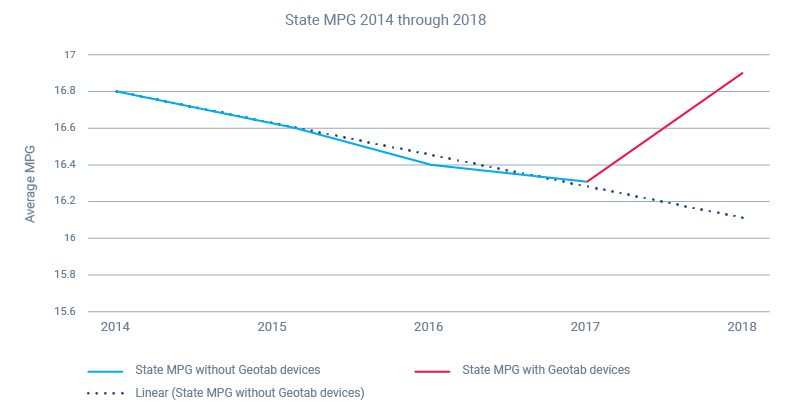
Figure 4. Average MPG of four core pilot agency vehicles (2016-2018)
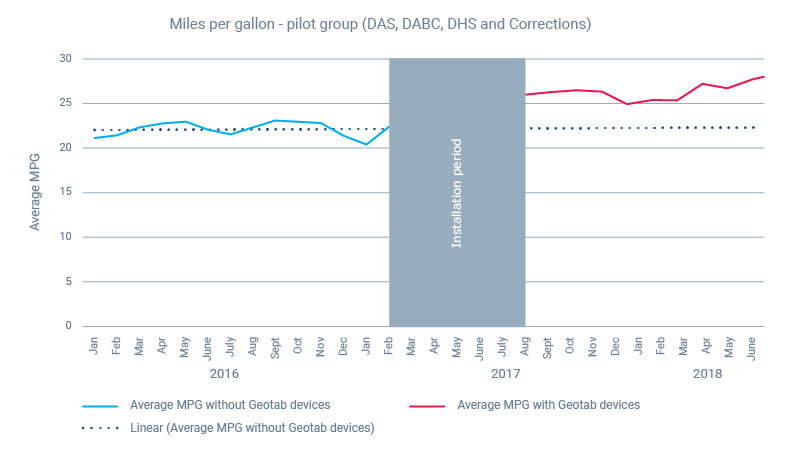
Maintenance savings
Since the deployment of telematics, work order costs within the four program agencies have decreased by $90K compared to 2017, and $75K compared to previous years, representing a 20% improvement since June 2017. These vehicles produce over 4,000 work orders per year, which represents a large portion of each vehicle’s total cost of ownership.
As a result, the following savings have been realized (2):
- $7,500 monthly savings ($6.90 per vehicle per month)
- $90,000 annual savings ($82 per vehicle per year)
Maintenance savings were achieved by monitoring aggressive driving, check engine light alerts and low battery notices. Mottishaw says, “Geotab has just nailed it perfectly. We can set up rules specific to the use-case scenario without additional staff effort.” He appreciates the reporting features that enable management to be notified through scheduled emails or by real-time alerts when an issue needs to be addressed.
Figure 5. Cost of work orders of four core pilot agencies (2014-2018)
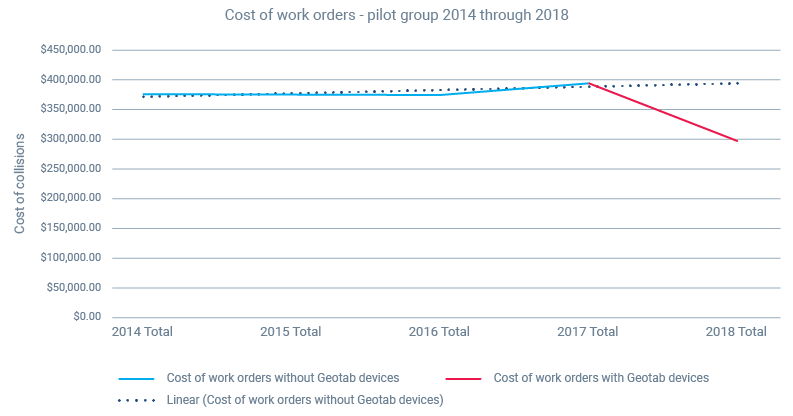
Accident savings
Since implementing telematics within the four pilot agencies, first party collision costs have lowered by $36.7K when compared to historical trends, representing a 21% reduction.
These collision costs are summarized below.
- $4,763 monthly savings ($4.30 per vehicle per month)
- $56,760 annual savings ($52 per vehicle per year)
Accident savings were achieved by monitoring seat belt usage and driving behavior. Gardner says it was surprising to find out how many drivers were not consistently using seat belts. “It’s amazing to be able to have your hands in the data,” he explains, “and to make decision that benefit the fleet and your driver’s lives.”
Figure 6. Total cost of accidents for State of Utah’s fleet operations vehicles (2013-2018)

Figure 7. Seat belt usage trend (2017-2018)
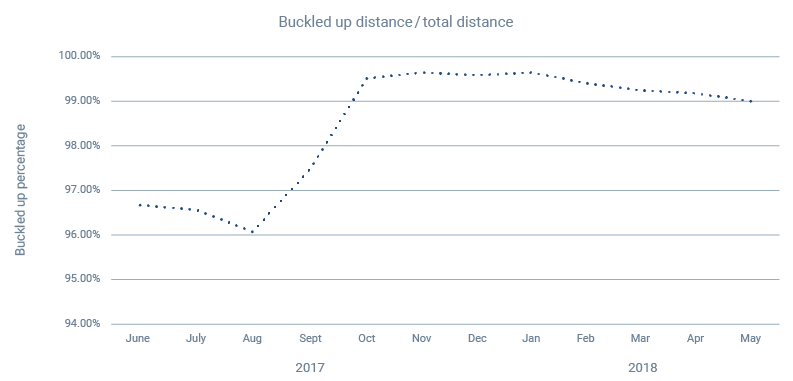
Vehicle utilization savings
Telematics solutions also offer valuable insight regarding fleet utilization. According to the State of Utah’s current mileage standards, 340 vehicles in the four pilot agencies do not meet the minimum monthly mileage standard. By eliminating these vehicles, the division stands to save a significant amount of money (2):
- $89,500 monthly savings resulting from eliminated depreciation expenses ($82 per vehicle per month)
- $1,074,400 annual savings resulting from less collisions ($985 per vehicle per year)
Figure 8. Vehicle mileage utilization of four core pilot agencies (2017-2018)
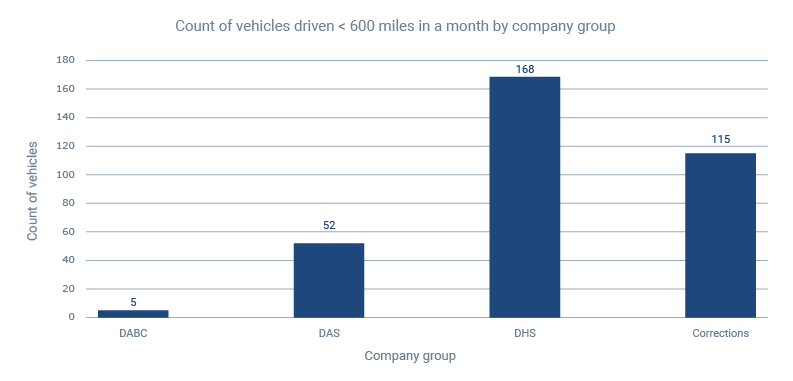
Additional benefits
The State of Utah identified another two areas of incremental benefits for agencies:
- Streamlined reporting and billing: DHA successfully increased productivity and efficiency by using telematics-integrated Driver ID fobs. Before using a vehicle, each DHA employee swipes the Driver ID fob to assign themselves as the operator of the vehicle for that trip. Vehicle and driver information is automatically reported to the system, no longer requiring extra lookups. Now DHA can quickly run internal bill back reports instead of manually billing from paper trip logs. Corrections and the DHS are also rolling out Driver ID fobs.
- Safety for remote workers: Employees in the State of Utah Department of Agriculture predator control program may work remotely in mountain areas, out of cellular network coverage, for weeks at a time. By equipping their vehicles with Geotab’s satellite connected telematic units and a distress button, the State can provide employees with a means of notifying staff of an issue and providing location details. In the case of an emergency, this connectivity could speed up response and potentially save a life.
Short-term savings summary
Based on the study of 1,091 vehicles from the four pilot agencies (DAS, DABC, DHS and Corrections), the State of Utah generated a summary of savings values based on monthly and annual analyses, excluding utilization savings (2).
Table 2. Savings summary (with telematics in 25% of fleet)

Conclusion
Key findings of the State of Utah pilot study of Geotab telematics:
- There is a significant positive correlation between the installation of telematics units in agency customer vehicles and improvements in key cost saving areas.
- There appears to be a more positive correlation between driver behavior and real-time in-cab alerts.
- At the current level of estimated savings the pilot is more than paying for itself.
- The State of Utah gains approximately $2.05 per vehicle per month additional savings above the cost of the program, according to an analysis performed at the University of Utah (2).
The State notes that making a conclusive determination as to the level of correlation would require more data.
Mottishaw says telematics solutions may sound too good to be true, but his experience has been that you can obtain tangible fleet improvements. He says the Geotab platform more than pays for itself by enabling the fleet to achieve significant savings.
Mottishaw credits telematics for helping fleet managers do their job better because of access to information that was previously unavailable. Gardner agrees, adding, “You can answer questions that you wouldn’t have been able to answer before without the data.” In his opinion, the most rewarding part of the process has been that “it actually works.”
Looking ahead
Based on current savings, the State of Utah deems that the pilot is successful and warrants further investigation and extending the program for an additional 12 months. The full value of the pilot program will be seen as the participating agencies move forward on publishing and enforcing internal policies regarding telematics rule thresholds, and proactive driver coaching and safety initiatives.
Evolving technology will continue to bring new opportunities to government fleets, and the division intends to take advantage of innovations like predictive analytics and smart state insights. The possibility of moving from reactive to predictive maintenance cycles, among other capabilities, is becoming a reality with telematics. Fleets are also a potentially rich source of data that can be used to generate city or statewide insights to improve transportation efficiency, citizen safety and environmental sustainability. With the Geotab platform in place, the agency is poised for expansion during Industry 4.0, putting the State in a secure position to handle further disruption.
For more information
To learn more, please visit: www.geotab.com/government
References
- Marr, Bernard. (2016, Jun 20). What Everyone Must Know About Industry 4.0. Forbes. Available: https://www.forbes.com/sites/bernardmarr/2016/06/20/what-everyone-must-know-about-industry-4-0/#2426b342795f
- Mottishaw, J. and Brown, M. (2018, Sep). Geotab Pilot Study: Year One Summary Report. State of Utah, Department of Administrative Services, Division of Fleet Operations.
- Pilon-Bignell, J. and Milne A. (2016, Jun). Increasing Fleet Profitability with Telematics: COI vs ROI. Geotab. Available: https://www.geotab.com/white-paper/fleet-profitability-coi-roi/
- Fleet Savings Summary. Geotab. Available: www.geotab.com/marketplace/custom-report/fleet-savings-summary
Editors: Jean Pilon-Bignell and Melanie Serr
Post Tags
About Geotab
Geotab is a global leader in connected vehicle and asset solutions, empowering fleet efficiency and management. We leverage advanced data analytics and AI to transform fleet performance, safety, and sustainability, reducing cost and driving efficiency. Backed by top data scientists and engineers, we serve over 55,000 global customers, processing 80 billion data points daily from more than 4.7 million vehicle subscriptions. Geotab is trusted by Fortune 500 organizations, mid-sized fleets, and the largest public sector fleets in the world, including the US Federal Government. Committed to data security and privacy, we hold FIPS 140-3 and FedRAMP authorizations. Our open platform, ecosystem of outstanding partners, and Marketplace deliver hundreds of fleet-ready third-party solutions. This year, we're celebrating 25 years of innovation. Learn more at www.geotab.com and follow us on LinkedIn or visit Geotab News and Views.
© 2025 Geotab Inc.All Rights Reserved.
This white paper is intended to provide information and encourage discussion on topics of interest to the telematics community. Geotab is not providing technical, professional or legal advice through this white paper. While every effort has been made to ensure that the information in this white paper is timely and accurate, errors and omissions may occur, and the information presented here may become out-of-date with the passage of time.
Recent News

Telematics for winter operations: How Massachusetts DOT balances safety, efficiency & sustainability
September 21, 2021

Data-driven smart city insights: intelligent datasets and urban analytics for digital cities
September 1, 2017

Geotab Ace: Revolutionizing Fleet Management with Responsible Generative AI
December 2, 2024

Sustainable fleet management: data-driven insights to enhance the bottom line
July 2, 2024